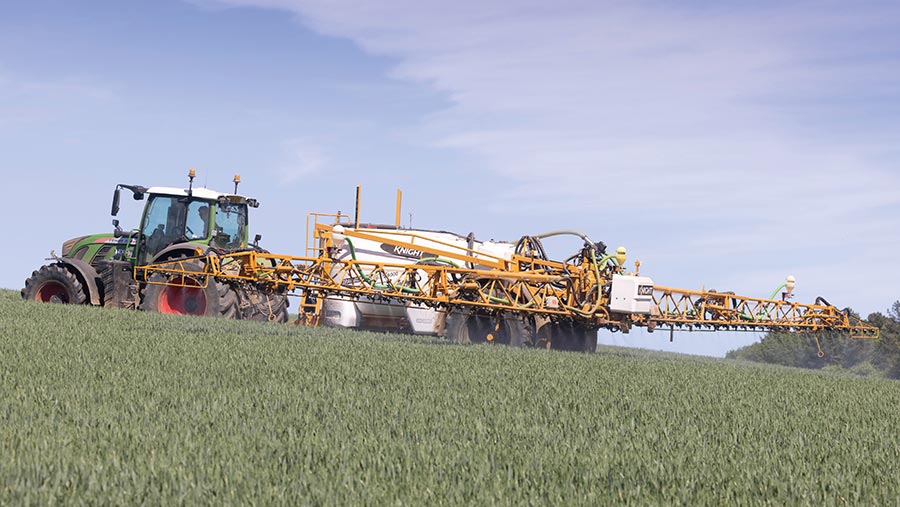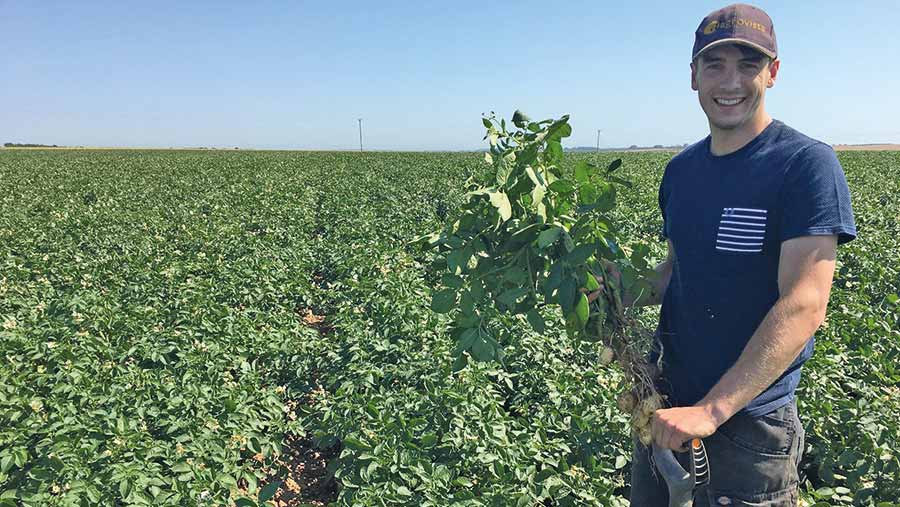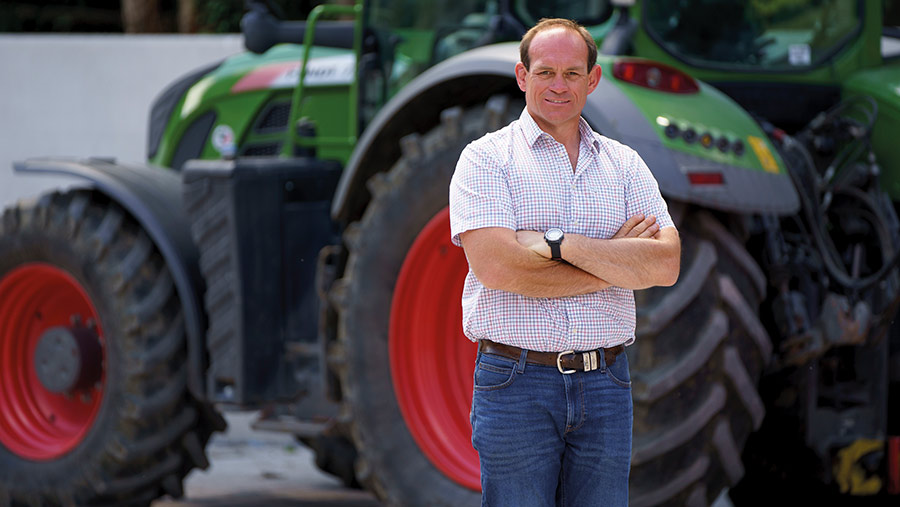How will price pressures affect fungicide decisions on farm?
 Spraying winter wheat © Tim Scrivener
Spraying winter wheat © Tim Scrivener Protecting winter wheat from key yield-robbing diseases during spring and summer is crucial for overall arable business profitability.
But with grain prices dipping, hopefully temporarily, below £200/t at one point in March, a lot of fertiliser bought towards the top of the market and fungicide prices rising by as much as 25% on last year, the cost squeeze many growers feared is becoming reality.
See also: Will arable farmers opt for Sustainable Farming Incentive?
So how will that affect growers’ plans for wheat disease control this spring? Our eight-strong Arable Insights farmer group have some different approaches.
East Anglia: James Sills

James Sills © James Sills
“I like it because it helps take out some of the emotion, so you don’t get too caught up in the moment of whether it is a high or low disease pressure year.”
Using the tool was part of the reason why he invested in new Champion seed this autumn, with it indicating the possibility of a reduced fungicide spend compared with Gleam, plus a higher potential yield.
Gleam still features on the farm, but Champion and Extase, with good disease resistance to both septoria and yellow rust, form a large chunk of the area, with smaller areas of Zyatt and Dawsum also being grown.
About 80% of Mr Sills’ fungicide requirements for this season were bought at the end of last season.
“I don’t think it took a genius to work out prices were going up when they hadn’t gone up much at all last year, so we bought as much as we could at the end of the season. It’s probably going to save us 20% of what we would pay this spring.”
It doesn’t include Univoq after he sent back around £20,000 worth of product in-season following the sprayer concerns.
T0s – a simple tebuconazole – will be used on Gleam and Zyatt, with Extase and Champion unlikely to need it, he says, with Ascra and Revystar being used for T1 and T2 respectively, with rates to be determined at time of spraying.
“If it is low disease pressure, we might consider something a bit less on Extase at T1, but I think everything will get Revystar at T2 at various rates.”
It’s generally worth spraying an ear spray, he says, with tebuconazole plus or minus generic prothioconazole the typical choice.
North: James Pick

James Pick @ James Pick
The aim for James Pick in the next 10 years is to grow crops without any fungicides by improving his soils to grow healthy plants that are balanced enough in all nutrients to fight off disease.
“That’s not going to happen overnight,” he admits.
“To help bridge the gap until our soils are in good enough condition to achieve that, we’re using sap analysis to track what’s happening in our plants and try to avoid any spikes of nitrates.”
The analysis helps to make sure plants have enough of other key nutrients, such as magnesium, manganese, iron and copper, to help convert nitrogen into amino acids and proteins, he explains.
“Nutrition is the biggest factor in how we are reducing our fungicide use.”
He’s also growing a six-variety wheat blend – Dawsum, Extase, Revelation, Theodore, Gleam and Cranium – which is helping reduce what was previously the biggest disease risk on the farm – yellow rust.
“Most are strong in terms of yellow rust resistance with a broad spectrum of parentage, which is also giving confidence in reducing fungicides.”
While last year one field was successfully grown without any fungicides, wheat is a profitable crop on the farm’s soil type, so generally at least a flag leaf fungicide will be used, Mr Pick says.
“If you look at the data, even exceptionally resistant varieties, such as Extase, still give a yield response to fungicides.
“I expect to use a good fungicide at T2, but on certain fields we will continue to push the boundaries.”
South West: Emma Foot

Growing two disease-resistant varieties in Dawsum and Extase should allow Emma Foot and her father to cut back on fungicides in wheat this spring as input prices increase.
Drilled in mid-October to help reduce the risk of barley yellow dwarf virus, it also helps as a cultural control reducing the risk of septoria.
“We’re quite fortunate compared with some growers in the region who have heavier soils, in that we can be quite picky about when we drill,” she says.
“In some years we have drilled as late as mid-November, but the forecast didn’t look great, so we got on with it in October.”
Septoria is the main concern and with good varietal disease resistance against yellow rust, Miss Foot says they will cut out the T0 this season.
“Usually we do spray T0, T1 and T2s, and sometimes a T3.
“Obviously, we would rather not use fungicides, regardless of the price of wheat, if you can get away with it, but if it needs a fungicide it is better putting it on than risking more yield loss. But it very dependent on the weather.”
Both main timings will likely be based on SDHI-containing fungicide chemistry, with a strobilurin fungicide added if there is a rust risk, although she says that tends not to be a big problem on the farm.
Univoq has been discussed with Agrii agronomist Todd Jex, but its expense, combined with the uncertainty over whether it could damage the sprayer, has led Miss Foot to decide to go down the SDHI route this season.
Ear sprays, if required, will be based around tebuconazole to protect against fusarium and late season brown rust.
Active ingredients
- Ascra – bixafen + fluopyram + prothioconazole
- Elatus Era – benzovindiflupyr + prothioconazole
- Flexity – metrafenone
- Revystar/Verydor – mefentrifluconazole + fluxapyroxad
- Univoq – fenpicoxamid + prothioconazole
- Zoxis – azoxystrobin
Northern Ireland: Simon Best

Simon Best @ Steffan Hill
Rainfall of typically more than 850mm makes septoria the major concern for Simon Best in his single wheat variety, Graham, which he’s grown for the past six seasons.
“We’re feed wheat growers as there is no milling market in Northern Ireland due to strong livestock demand and the challenge of meeting the milling spec consistently is difficult.”
Feed wheat usually trades at a premium in Northern Ireland as a net importer, compared with the rest of the UK which is a net exporter.
While the recent drop in wheat price has caused concern, he’s planning to stick with similar fungicide programmes to last season, with crop potential looking good.
“We’re targeting a 10t/ha wheat crop and if we’re going to reduce fertiliser inputs, keeping the crop healthy is important to maintain quality.”
He’s tried reducing fungicide applications to three, but has found that less consistent than a four-spray programme.
“That shows that maintaining good disease control is key.”
His first application, which he calls a T0.5, is with a strobilurin, Zoxis, and mildewicide, Flexity, before using newer chemistry in the form of Verydor and Univoq at T1 and T2 respectively.
Ear sprays will be tebuconazole plus folpet.
“We had no problems last year with Univoq, but with the Corteva guidance we will probably increase our water rates to 150 litres/ha and also add in the adjuvant Kantor, which maybe is a help.”
Mr Best also uses sap analysis to help guide nutrient applications during the season to keep the crop healthy, but hasn’t found so far that it is enabling him to reduce fungicide inputs.
Midlands: Will Oliver

Will Oliver © Tim Scrivener
While Will Oliver leans towards orange wheat blossom midge-resistant varieties wherever possible, a combination of market requirement and sticking with varieties that have worked well on the farm in the past mean there is a certain reliance on fungicides, he admits.
“Cultural controls are a cost-effective way of reducing risk, but at the same time we see great responses from fungicides, and with varieties such as Skyfall becoming more challenging with yellow rust, it is important not to take your foot off the pedal with disease control.”
That means regular field walking to keep on top of yellow rust and septoria, as well as watching out for eyespot and brown rust.
With up to 25-30% price rises for fungicides this spring, he’s pleased he took the risk of buying SDHI fungicides in December.
Both Skyfall and Insitor, with yellow rust weaknesses, will receive tebuconazole at T0. It will be omitted on Siskin, which tends to be later drilled and has good rust resistance.
The T1 spray is likely to be Elatus Era, which is already in stock, plus additional azole fungicide and folpet, if felt necessary, with Revystar, Elatus Era or Univoq featuring at T2.
Rates will be tailored towards variety risk and sowing dates.
“We used Univoq last year with very little issue, but will also act with caution, which means we may lean towards Revystar or Elatus Era,” Mr Oliver says.
West: Mark Wood

Mark Wood © Richard Stanton
Good varietal disease resistance is important for Mark Wood, given the climate in the West, and although the timing of drilling in recent seasons has been pushed back, it still starts in mid- to late September.
Growing Extase, Graham, Costello and this year some Dawsum with a view to it replacing Costello, septoria is the main concern, with programmes usually covering any yellow rust or eyespot risks.
With all those varieties, fungicides remain important, but better disease resistance brings greater flexibility with rates and product choice.
Planning starts pre-season to make sure there is a mixture of risk across the farm, with higher risk crops prioritised.
He’s unlikely to use a T0, with low yellow rust risk and no economic return from a septoria-focused T0 spray.
“The T1 will be based on an SDHI – which one will depend on how much rain we get. After this wet period in March we’re escalating up towards Ascra and possibly Revystar if the rain carries on, because it is going to be conducive for higher risk.”
At T2, he thinks Univoq is a step above the alternatives for septoria so will consider using it, especially if pressure is high.
“It’s a very good product. We didn’t have big problems with it, but did have to replace the ChemSaver seals in the booms last year, just after using it because they started leaking.
“So if it is a high disease pressure year, we’ll be looking at using Univoq, but we’ll do it with our eyes open and will be a little nervous.”
Scotland: Amy Geddes

Amy Geddes © Amy Geddes
Careful and targeted use of fungicide is always important, Amy Geddes says, but even more so with the drop in grain price and increase in input costs.
Recently purchased Revystar, for example, cost about £10/litre more than last year, she says.
AHDB Farmbench analysis has revealed quite a big chunk of crop cost in wheat is fungicides.
“Having seen the huge price increases in some products we’re buying, careful and targeted use is key to a return on investment.”
A couple of fields of wheat after potatoes are earmarked for reduced programmes given the later sowing date.
“We will try not to spend as much overall if the crop is unlikely to reach full potential.”
Disease control programmes for the Swallow, Dawsum and Skyscraper wheat are planned in conjunction with Eric Anderson from Scottish Agronomy.
From last year’s experience, Swallow can be susceptible to mildew and yellow rust due to the farm’s coastal location, so a tebuconazole plus mildewicide is likely at T0, with tebuconazole on earlier sown Skyscraper.
While plans are still very much in flux, Univoq could be used at T1 with Revystar as the T2 spray, she suggests, following on from good results last year.
“We haven’t had any issues with Univoq – our sprayer has a centrifugal pump and not a diaphragm, which may have helped or just the combination of the concentration of the spray solution and good sprayer hygiene, but we’d be happy to use it again.”
South East: Doug Wanstall

Douglas Wanstall © MAG
Minimising fungicide use is a key aim within Doug Wanstall’s regenerative system, with weekly monitoring used to help keep on top of decision-making.
Drilling date has been pushed back until mid-October, mainly because of grassweed concerns, which helps with his main disease concern, septoria, as does, he hopes, growing a blend of three milling varieties – Extase, Crusoe and Zyatt.
Up until recent rain there wasn’t much disease in the base of crops, and he’s still not anticipating many early issues. He likes to avoid T0s so he doesn’t apply fungicide directly on to the soil.
“But we are pragmatic – if there is an overwhelming level of disease we’d clearly do something about it,” he says.
Last year, he applied three fungicides on wheat, but hopes to get away with just two this season, with a cheaper product used at T1 and a higher spend at T2.
That’s unlikely to be Univoq though, he says, preferring to use a cost-effective SDHI fungicide.

